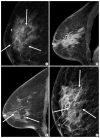Imaging features of breast cancer molecular subtypes: state of the art
- PMID: 33153242
- PMCID: PMC7829574
- DOI: 10.4132/jptm.2020.09.03
Imaging features of breast cancer molecular subtypes: state of the art
Abstract
Characterization of breast cancer molecular subtypes has been the standard of care for breast cancer management. We aimed to provide a review of imaging features of breast cancer molecular subtypes for the field of precision medicine. We also provide an update on the recent progress in precision medicine for breast cancer, implications for imaging, and recent observations in longitudinal functional imaging with radiomics.
Keywords: Breast neoplasms; Gene expression profiles; Magnetic resonance imaging.
Conflict of interest statement
The authors declare that they have no potential conflicts of interest.
Figures




References
-
- Prat A, Pineda E, Adamo B, et al. Clinical implications of the intrinsic molecular subtypes of breast cancer. Breast. 2015;24(Suppl 2):S26–35. - PubMed
Publication types
LinkOut - more resources
Full Text Sources
Other Literature Sources

